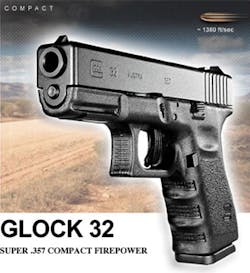I feel lucky that during the course of my professional life span (about 26 years now) I've seen the evolution of several new handgun cartridges: the .40S&W, the .357Sig and the .45GAP to name a few. As a cynic I look at each in doubt until they've been proven "on the street". I also tend to measure them against what I consider to be the tried and true service cartridges - the 9mm and the .45ACP. This week I'm reporting on my test work with the Glock Model 32; Glock's mid-size version chambered for the .357Sig cartridge.
Before we get into the gun we need to understand the cartridge it's built around. Most shooters alive today are familiar with the venerable .357 Magnum round. This cartridge, loaded and fired from a 4" or 6" barreled revolver, typically launched a 125g (bullet) projectile at speeds approaching or faster than 1400 feet per second (fps). The development of the .357 Magnum is generally credited to Elmer Keith who was able to experiment with loadings using a .44 Magnum size frame but built to shoot .38 Special size bullets. The ever-present enemy of high-powered cartridges, chamber pressure limits were addressed (eventually) by lengthening the case of the .38 high velocity loads by 1/8 of an inch but maintaining the bullet diameter. Smith & Wesson made the first .357 Magnum revolver with Col. D. B. Wesson working with NRA Technical Staff Division member Phillip B. Sharpe. Between them the .357 Magnum was born in the 1930s.
Sixty-some-odd years later with pistols flourishing in the military and law enforcement communities, the need to duplicate the power of the legendary .357 Magnum was seen. How to do it in an easily held sufficient capacity pistol was the problem. Thanks in part to the development of the .40S&W in the late '80s (debuted in January 1990), Sig-Sauer was able to develop a pistol cartridge that fired a .355 caliber bullet from a necked down .40S&W case. While some believe that the case is actually the same, the .357Sig case is slightly longer than a normal .40S&W case. The fact that pistols chambered for the .357Sig can be identical to the same pistol chambered for .40S&W with the exception of the barrel have has helped the caliber gain in popularity. After all, if you buy a pistol chambered for .40S&W and then buy the barrel for .357Sig, you can shoot either (in some weapon designs) by simply changing out the barrel. For instance, with the Glock 3rd generation guns, this can be done converting the Glock 23 (.40S&W) to .357Sig, or the Glock 32 (our topic today and .357Sig) to .40S&W.
Typical performance shows that the cartridge pistol combination launches:
- 115g bullets at about 1550 fps
- 125g bullets at about 1450 fps
- 147g bullets at about 1250 fps
The 2nd loading - the 125g bullet leaving the barrel at about 1450 fps (depending on the manufacturer, powder load, barrel length, etc) comes closest to matching the 125g .357 Magnum load performance. The difference is that given today's engineering capabilities and the capacities we see in common pistol designs, our Glock 32 test gun holds 14 rounds of .357Sig as compared to the revolver's capacity of 6 (or 7 in modern designs). The Glock 32's larger and smaller "brothers", the Glock 31 and Glock 33 respectively, carry 16 (15+1) and 10 (9+1) rounds. Even the smallest of this family of guns carries nearly double the capacity of the traditional revolvers.
So what about the gun itself? The Glock 32 shares all of the same design attributes as other Glock pistols. In the 3rd generation guns the polymer frame incorporates a picatinny standard rail mounting system on the dust cover. The grip area is comparatively slim with finger grooves molded in. The slide is finished with Glock's Tenifer treatment which they tout as harder-than-steel and corrosion resistant. Truth be told I've never seen rust on a Glock. The same three safeties exist as on every Glock pistol:
- The trigger safety
- The drop safety
- The passive firing pin block
On the 3rd generation Glocks the extractor does double duty as the chamber loaded indicator and it can be seen or felt protruding when the chamber is loaded. Some of the data points are:
- Weight: Just over 30 ounces (less than two pounds)
- Length: 6.85"
- Height: 5"
- Width: 1.18"
- Barrel Length: Just over 4"
- Sight Radius: Just over 6"
- Rifling: right hand, hexagonal, 1-in-16" turn
- Trigger pull: 5.5 pounds standard
That's all OBJECTIVE data; what about the SUBJECTIVE stuff? Time on the range shows that the weapon / cartridge combination is more than sufficiently accurate. Keep in mind two things: this mid-size Glock isn't meant to be a competition gun, hostage rescue precision weapon, etc. Although it CAN serve those purposes, that's not what it was designed for. It was designed to be a sufficient weapon for duty use, but slightly smaller / more compact for concealed carry off-duty or in plain clothes. For better concealability obviously you'd go with the Glock 33. For a full size duty weapon you'd go with the Glock 31. The Glock 32 is a compromise to suit both purposes in a single gun.
Accuracy is what you'd expect from any modern design pistol. From the 15-yard line, shooting unsupported, I could produce 2 to 2.5" groups of five-shots with no issues. I'm sure the gun can shoot better than I can especially since I'm very aware of the difference in recoil I feel when shooting this caliber. I'm used to the recoil "profiles" of the 9mm, .40S&W and the .45ACP. With the .357Sig (and the 10mm) I notice the faster movement of the slide and the much smaller arch of recoil. The recoil feels sharper to me. It's not unpleasant but I do notice it and it does affect my shooting (unless I really pay attention). The weapon is as comfortable in my hand as all of the identical size Glocks which include the Model 19 (9mm) and Model 23 (.40S&W). Because of that size match there are plenty of holsters out there to fit the weapon.
Having 13+1 rounds in the weapon with the usual two backup magazines means you get 40 rounds of .357Sig in a typical police load. That's sufficient for most situations and if we need more perhaps we should have grabbed the patrol rifle out of its lock (or our trunk).
All in all I find this to be a suitable duty weapon. The caliber performance makes it stand out while the "traditional" Glock design features make it familiar. If you want a pistol that is closest to the .357 Magnum performance of yester-year, this is the caliber / weapon to choose. If you want ONE weapon that lets you choose between TWO calibers by switching out the barrel, this and the Glock 23 are what you should look at.
Stay Safe!



